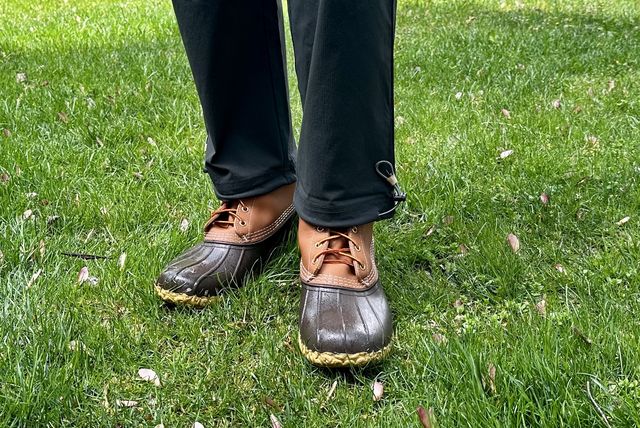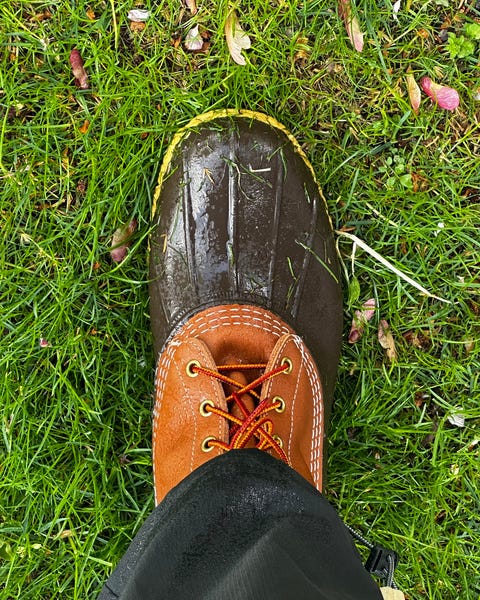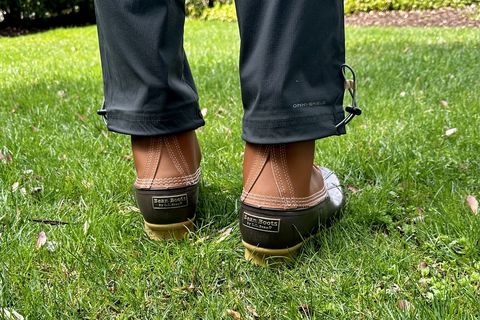A number of brands have flagship products: the designs, whether they're the Apple iPhone or the Levi's 501, that pushed them to the next level — into the fold, to the mainstream. For outdoor brand L.L. Bean, despite the popularity of its Boat and Tote bag, it's the Bean Boot.
It's among the most famous eponymous products of all time — and one of the easiest to spot, too, despite there being myriad remakes available now. With its rubber sole, leather upper and duck boot toe box design, you can see someone splashing through puddles in a pair of these a mile away.
But, do the boots, which originally launched in 1912, still stand up today? And, if so, are they worth the $149 L.L. Bean charges now? We found out.
L.L. Bean Bean Boots: What We Think
Tried, true and still Maine-made, L.L. Bean's eponymous Bean Boots feature a rubber sole with a steel shank for foot support and a weather-resistant leather upper. All in all, this makes them the ideal footwear for rainy or snowy days, but they aren't designed to stay submerged in water — i.e. no soaking wet worksites, please.
As for how they feel, we found they were comfortable and still well constructed, thanks to the aforementioned sole and lifted heel, but they're slightly unstable because of the latter, which meant slight rolls of my ankle until I got used to them. The malleable shafts don't help here, but they do prioritize comfort, which means you won't suffer through a harsh break-in period. I did find, though, that they rubbed at my heel, which was likely a product of me ordering the wrong size — something that's easy to do because of the semi-strange sizing scale.
L.L. Bean Bean Boots: Testing Notes
They're an iconic product with a timeless look.
First built in 1912, L.L. Bean's iconic Bean Boots were then called the Maine Hunting Shoe, but have since adopted more colloquial catch-alls: Bean Boots or Duck Boots, for short. (They're really just rain boots, though.) The brand's founder, Leon Leonwood Bean, first stitched them together for his own journeys, but eventually sold 100 pairs to close friends and family members — as well as others in Maine. He grew tired of traditional boots that'd get soggy in the sole, therefore combining the comfortability of rubber-soled shoes with the durability promised by leather uppers.
As the story famously goes, though, 90 of the first 100 boots sold were returned. As early prototypes, they came without Bean's now-famous triple-line stitching finish, which secures the rubber outsole to the leather upper. Those early pairs came apart, but this incident spurred perhaps the brand's most popular design feature — maybe behind the duckbill toe, though.
Finding the correct size is a game of trial and error.
Finding the right size is a complex riddle: "With light or mid-weight socks," the brand says, "Whole sizes, order one size down. Half sizes, order 1.5 size down. Example: 9 or 9.5, order a size 8. With heavyweight socks: Whole sizes, order your normal size. Half sizes, order one size down. Example: 9 or 9.5, order a size 9."
I, for one, went with my usual size: a US 12. I figured I'd only wear these with thick socks, or, so what I thought constituted as thick socks. (Maybe I should've stayed in-brand.) Even with my thicker boot socks, these felt a little big, cementing my statement that even with brand guidance, you might end up with boots that are a little big.
If the size is off, they tend to slip at the heel, creating friction.
With sizing issues comes shifting, which causes blisters. During the first half-dozen wears, my heel consistently lifted out of the cup and rubbed on the rear spine, causing red spot that came just short of becoming a painful blister. Again, this is partly my own doing by suffering through what I'd assume is the wrong size, but I'm sure I'm not alone — hence this warning.
They're definitely waterproof.
Pittsburgh, where I live, and where I tested these boots, gets a lot of rain. More than Seattle, in fact. As such, I had ample opportunities to test these: through light springtime mists, end-of-summer rain storms, dewy, early-fall mornings and mid-winter downpours, which we got in lieu of snow.
These boots worked well in every situation, thus confirming their ability to keep your feet dry no matter how much (or which kind) of precipitation you get. Plus, given the raised heel and 8-inch shaft, you're guaranteed to keep dry even if the water level rises past puddle-height.
If the size is off, they're a little wobbly to walk in.
I'm fairly used to the flat leather outsoles on traditional boots, or the grooved rubber ones on some of my favorite work boots. But, the outsole on the L.L. Bean Bean Boots is quite different, especially given the rear heel. The rubber's fairly soft — it is rubber, after all — which means there's a fair bit of bounce.
As someone with flat feet that somehow still supinate, I felt a little off balance in these, even though I never went as far as rolling my ankle or falling over. On muddy grass, I got better footing, but walking on city sidewalks, I felt a little... weird in these.























